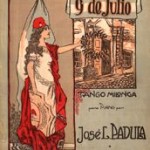People have told me that in this blog I put too much weight on modern and NeoTango music. I agree, I confess and I regret. Actually I would like to start a new series of articles with more traditional focus, but I again want to concentrate on musical themes and some basic knowledge for educated tangueros/tangueras.
So there are some typical tangos, everybody knows and most of us can identify and name with the original title in Spanish. Usually, they (let us call them “big tangos”) have been played by different orchestras and they have an established position in international Tango folklore.
For some of them a story can and will be told. Some have very special lyrics, some of them don´t have lyrics at all. Some are difficult, some are simple.
Today we start with the Tango “Nueve de Julio” or “9 de Julio”. This tango is just instrumental, it is in it´s original form not really sophisticated, but it is famous and everybody knows it.
Here the interpretation of Jorge Mosso (bandoneon solo), who plays the song (almost) in the original style:
Ok, initially, it is not a real gem of music, but interestingly, this is exactly, what made the song a “big” one. Let us first have a close look at the song. Todotango [1] gives us a free picture of the sheet music.
In the version for piano, the song is written in 2/4 time signature and starts in g flat, the left hand plays a habanera rhythm, the right hand the melody. Actually the song consists of three parts, Part A is the main theme which comes in 2×8 bars and is repeated once, so this part looks like AA.
Then a B part, consisting again of 2×8 bars is played, again repeated, which can be written as BB.
Part A is repeated (“repite primera parte, despues trio”) and then comes a third part called trio again made out of 2×8 bars which are repeated. I write it as CC
So the whole structure is: AABBAACC. So the musical piece can be classified as a ternary song structure (ABA) [2] with an added part C. The name “trio” comes from the old minuet form, where a purely instrumental part was in between two minuet dances [3]. This part usually was played with three instruments, which gave it the name “trio” (musical piece played by three instruments). Actually here the additional part is called a trio.
The song was composed 1918 by Jose Luis Padula in Rosario without vocals. Jose Luis, living there as a poor bohemian sold the song to a Mr. Trebino for just 5 dineros [4]. Orchestras adapted the song and added their own contrecanti and even additional parts. Here is a version from 1930 by Orquesta Luis Petrucelli who plays the typical contrecanti, which became popular among later orchestral versions:
So what happens on 9 de Julio (9th of July)? On 9th of July 1816, the congress of Tucuman declared the independence of Argentina from Spain, establishing it as country. In Argentina, this is celebrated as a public holiday. The avenida de 9 de Julio (with the obelisco located at the intersection with Av. Corrientes) is the widest avenue in the world [5].
Back to music. Lots of Orchestras have played 9 de Julio. The most well known of them is the Orchestra of Juan D´Arienzo, the master of rhythm. It is very likely to hear one of his versions in a Milonga. With his special staccato rhythms he is still present today as an example of utmost rhythmical power. Juan D´Arienzo usually plays his songs in the usual way, but he adds a final part to each song where he shows of his rhythmical power in a very special way. These final part can be called “coda” or “adlib”. Please have a close look at his typical interpretation (the coda starts here at around 2:40):
Another video actually shows the big master himself playing the song:
https://www.youtube.com/watch?v=8pS_qbG_tWU
Numerous versions of other artists can be found in the internet. Here just some examples:
The first version is a softer one played by H.Salgan, the second one the version by O.Pugliese (which is my favourite one) and the third one is a more contemporary interpretation by Collectif Roulotte Tango, sticking very much to the traditional sound and even to the coda of the great master himself, a true tribute to Juan D´Arienzo.
Finally we want to look at the dance side of Tango. Couples performing to 9 de Julio can be found easily.
Here two examples, Pasi & Maria Lauren performing in Finland and Julio Paloma & Maximiliano Alvarado from Chile in a stage tango competition.
Just to conclude: Why is this tango a “big” one ? In my opinion, it started as a simple piece of music and orchestra leaders had to add the contrecanti which became a fix part of the song. So the simplicity of this song allowed it to be honed by different orchestras into a nice and well known piece of Tango.
Have fun,
-Richard
References
1 http://www.todotango.com/spanish/las_obras/partitura.aspx?id=2173
2 http://en.wikipedia.org/wiki/Ternary_form
3 http://en.wikipedia.org/wiki/Minuet
4 http://www.todotango.com/spanish/creadores/jlpadula.asp
5 https://en.wikipedia.org/wiki/9_de_Julio_Avenue







![Part C (trio), only the first 4 bars, taken from [1]](http://tango.5toll.com/wp-content/uploads/2014/01/Part-C-300x75.jpg)